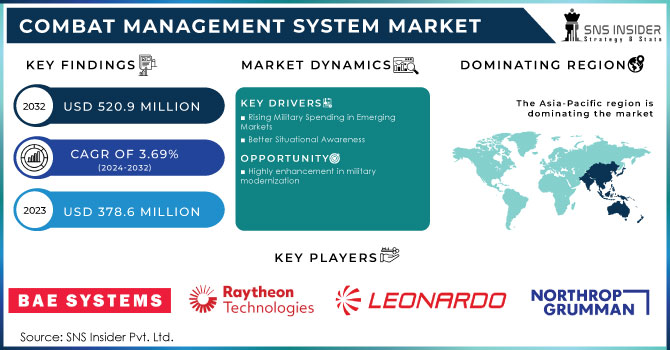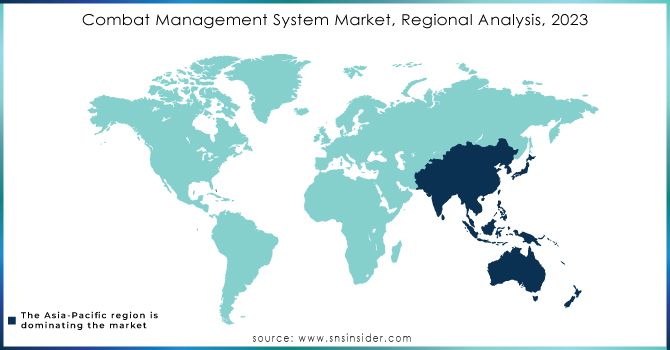Combat Management System Market Report Scope & Overview:
The Combat Management System Market Size was valued at US$ 378.6 million in 2023 and is expected to reach USD 520.9 million by 2032 with a growing CAGR of 3.69% over the forecast period 2024-2032.

To get more information on Combat Management System Market - Request Free Sample Report
The Combat Management System incorporates the central command and decision-making part of the anti-ship system. The program basically combines computer and software that combines ship sensors, weapons, radars, and data and other equipment into a single system. The program is designed to provide awareness and intelligence to employees so that they can perform combat duties effectively. Key functions of the War Management System include weapon control, threat surveillance, status check, photo integration, among others.
Combat Management Systems collects data around the sensors and radars. Collected data is collected, converted and distributed into usable intelligence. Modern CMS systems are capable of handling large amounts of data and monitoring thousands of positions and are highly automated and include command, control and communication capabilities. Some systems also have electro-optical infrared cameras, short-range missiles, and measuring devices designed to mislead visual systems.
MARKET DYNAMICS
KEY DRIVERS
-
Rising Military Spending in Emerging Markets
-
Better Situational Awareness
RESTRAINTS
-
Legacy Systems with Proven Capability and Integrity
OPPORTUNITIES
-
Highly enhancement in military modernization
CHALLENGES
-
High Cyber security threats
-
High Costs Associated with Communication Technology Implementation
IMPACT OF COVID-19
The COVID-19 situation has impacted research and development in combat management systems due to announced lockdown and government bans on public meetings.
The COVID-19 effect has caused a slowing in the economies of various countries, which may constrain government expenditure in the defence sector. Such a decrease in investment will have a direct impact on the growth of the battle management system industry. Because of COVID-19 travel restrictions, the battle management system's production pace has been severely damaged.
The combat management system is a huge system comprised of multiple components purchased from various corporations or imported from various nations. The supply chain of such parts has been severely harmed as a result of the global lockdown caused by COVID-19. The production of battle management systems has been halted due to a lack of spare parts.
As travel restrictions lessen around the world, there may be a significant increase in demand for combat management systems in the near future.
The growth of technology and innovation in the battle management system has developed over the years. Combat management systems are currently regarded as one of the top technologies for navy combat operations. However, the threat of anti-ship missiles has grown at the same time. However, such a threat can be mitigated or eliminated by strengthening the capabilities of navy ships. As a result, military ships require combat management systems to deal with such threats, adding to the growth of the combat management system market.
Destroyers Half of the destroyers are expected to respond with a large market share during the forecast. This growth could be due to the destruction of a fast, controllable, long-lasting warship, which could be used to escort larger ships by ship, line, or team and protect it from powerful short-range attackers.
Submarines Part of the submarines dominated the market, due to the growing acceptance of submarines developed by developing countries to strengthen their military capabilities. Half of the frigates are likely to record significant growth in the global market due to the growing demand for combat control systems used to manage, command, and control the Navy.
Shipwrecks Part of the submarines are expected to show significant growth in the global market as submarines are being used to land and support underground forces, such as the navy, in enemy territory during a water attack.
The portion of the corvettes is expected to grow by a very high CAGR during the forecast period as the corvette can be used to guard the coast, fight small battles, support large ships, or take part in flag-raising missions.
Fast Attack Craft This segment is expected to grow at a good rate of growth in the global market due to the growth of modern military systems around the world.
Carriers This segment is expected to reflect the level of continued growth in the global market due to the increasing demand for military aircraft worldwide.
Defense Control Program This component is expected to see significant growth in the global market due to the rapid increase in the purchase of advanced weapons worldwide. Status Awareness Program This component is expected to record significant growth in the global market due to the growing demand for conditional awareness developed by armed forces around the world.
Track Management System: This section is likely to reflect a positive growth rate in the global market as track management systems are used to compile track structure data, data analysis to assist maritime systems, and to monitor quality and accuracy.
Arms Management System This component is expected to testify to the rapid growth in the global market as arms control systems are widely used to identify, detect, monitor and track weapons.
Screening Program This component is expected to record the ongoing growth rate in the global market as these systems are used to assist naval officers and allow maritime authorities to monitor and monitor ship movements.
Uncontrolled Vehicle Control System This segment has dominated the global market and is expected to grow at a very high CAGR at the time of forecasting, due to the increasing demand for vacant motor vehicles.
KEY MARKET SEGMENTATION
By Component
-
Hardware
-
Software
By Sub-System
-
Self-Defense
-
Track Management
-
Identification
-
Unmanned Vehicle
-
Weapon Management System
-
Display System
By Platform
-
Destroyers
-
Submarines
-
Frigates
-
Corvettes
-
Aircraft Carriers
-
AFC
REGIONAL ANALYSIS
The combat management system is the fastest expanding system in the Asia-Pacific area, thanks to increased shipbuilding activity and a growing automotive sector. Economically stable countries such as India and China are encouraging shipbuilding and transportation of combat management systems in the region. The region's government has also raised funds to support the development of future-focused naval technologies. Europe is likely to see lacklustre growth during the forecast period.

Need any customization research on Combat Management System Market - Enquiry Now
REGIONAL COVERAGE:
-
North America
-
USA
-
Canada
-
Mexico
-
-
Europe
-
Germany
-
UK
-
France
-
Italy
-
Spain
-
The Netherlands
-
Rest of Europe
-
-
Asia-Pacific
-
Japan
-
south Korea
-
China
-
India
-
Australia
-
Rest of Asia-Pacific
-
-
The Middle East & Africa
-
Israel
-
UAE
-
South Africa
-
Rest of Middle East & Africa
-
-
Latin America
-
Brazil
-
Argentina
-
Rest of Latin America
-
KEY PLAYERS
The Major Players are Lockheed Martin Corporation., Raytheon Technologies Corporation, Northrop Grumman Corporation., Elbit Systems Ltd., Tata Advanced Systems Limited, Bharat Electronics Limited, Saab AB, Thales Group, BAE Systems., Leonardo S.p.A., KONGSBERG, and other players
| Report Attributes | Details |
|---|---|
| Market Size in 2023 | US$ 378.6 Million |
| Market Size by 2032 | US$ 520.9 Million |
| CAGR | CAGR of 3.61% From 2023 to 2030 |
| Base Year | 2023 |
| Forecast Period | 2024-2032 |
| Historical Data | 2020-2022 |
| Report Scope & Coverage | Market Size, Segments Analysis, Competitive Landscape, Regional Analysis, DROC & SWOT Analysis, Forecast Outlook |
| Key Segments | • By Component (Hardware, Software) • By Sub-System (Self-Defense, Situational Awareness, Track Management, Identification, Unmanned Vehicle,Weapon Management System, Display System) • By Platform (Destroyers, Submarines, Frigates, Corvettes, AFC, Aircraft Carriers) |
| Regional Analysis/Coverage | North America (USA, Canada, Mexico), Europe (Germany, UK, France, Italy, Spain, Netherlands, Rest of Europe), Asia-Pacific (Japan, South Korea, China, India, Australia, Rest of Asia-Pacific), The Middle East & Africa (Israel, UAE, South Africa, Rest of Middle East & Africa), Latin America (Brazil, Argentina, Rest of Latin America) |
| Company Profiles | Lockheed Martin Corporation., Raytheon Technologies Corporatio, Northrop Grumman Corporation., Elbit Systems Ltd., Tata Advanced Systems Limited, Bharat Electronics Limited, Saab AB, Thales Group, BAE Systems., Leonardo S.p.A., KONGSBERG, and other players. |
| DRIVERS | • Rising Military Spending in Emerging Markets • Better Situational Awareness |
| RESTRAINTS | • Legacy Systems with Proven Capability and Integrity |

